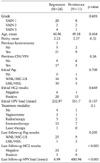1. Rutledge F. Cancer of the vagina. Am J Obstet Gynecol. 1967. 97:635–655.
2. Sillman FH, Sedlis A, Boyce JG. A review of lower genital intraepithelial neoplasia and the use of topical 5-fluorouracil. Obstet Gynecol Surv. 1985. 40:190–220.
3. Gallup DG, Morley GW. Carcinoma in situ of the vagina: a study and review. Obstet Gynecol. 1975. 46:334–340.
4. Minucci D, Cinel A, Insacco E, Oselladore M. Epidemiological aspects of vaginal intraepithelial neoplasia (VAIN). Clin Exp Obstet Gynecol. 1995. 22:36–42.
5. Sugase M, Matsukura T. Distinct manifestations of human papillomaviruses in the vagina. Int J Cancer. 1997. 72:412–415.
6. Sillman FH, Fruchter RG, Chen YS, Camilien L, Sedlis A, McTigue E. Vaginal intraepithelial neoplasia: risk factors for persistence, recurrence, and invasion and its management. Am J Obstet Gynecol. 1997. 176:93–99.
7. Audet-Lapointe P, Body G, Vauclair R, Drouin P, Ayoub J. Vaginal intraepithelial neoplasia. Gynecol Oncol. 1990. 36:232–239.
8. Benedet JL, Sanders BH. Carcinoma in situ of the vagina. Am J Obstet Gynecol. 1984. 148:695–700.
9. Dodge JA, Eltabbakh GH, Mount SL, Walker RP, Morgan A. Clinical features and risk of recurrence among patients with vaginal intraepithelial neoplasia. Gynecol Oncol. 2001. 83:363–369.
10. Solomon D, Davey D, Kurman R, Moriarty A, O'Connor D, Prey M, et al. The 2001 Bethesda System: terminology for reporting results of cervical cytology. JAMA. 2002. 287:2114–2119.
11. Castle PE, Schiffman M, Bratti MC, Hildesheim A, Herrero R, Hutchinson ML, et al. A population-based study of vaginal human papillomavirus infection in hysterectomized women. J Infect Dis. 2004. 190:458–467.
12. Daling JR, Madeleine MM, Schwartz SM, Shera KA, Carter JJ, McKnight B, et al. A population-based study of squamous cell vaginal cancer: HPV and cofactors. Gynecol Oncol. 2002. 84:263–270.
13. The Atypical Squamous Cells of Undetermined Significance/Low-Grade Squamous Intraepithelial Lesions Triage Study (ALTS) Group.Human papillomavirus testing for triage of women with cytologic evidence of low-grade squamous intraepithelial lesions: baseline data from a randomized trial. J Natl Cancer Inst. 2000. 92:397–402.
14. Logani S, Lu D, Quint WG, Ellenson LH, Pirog EC. Low-grade vulvar and vaginal intraepithelial neoplasia: correlation of histologic features with human papillomavirus DNA detection and MIB-1 immunostaining. Mod Pathol. 2003. 16:735–741.
15. Bell J, Sevin BU, Averette H, Nadji M. Vaginal cancer after hysterectomy for benign disease: value of cytologic screening. Obstet Gynecol. 1984. 64:699–702.
16. Ruiz-Moreno JA, Garcia-Gomez R, Vargas-Solano A, Alonso P. Vaginal intraepithelial neoplasia: report of 14 cases. Int J Gynaecol Obstet. 1987. 25:359–362.
17. Murta EF, Neves Junior MA, Sempionato LR, Costa MC, Maluf PJ. Vaginal intraepithelial neoplasia: clinical-therapeutic analysis of 33 cases. Arch Gynecol Obstet. 2005. 272:261–264.
18. Aho M, Vesterinen E, Meyer B, Purola E, Paavonen J. Natural history of vaginal intraepithelial neoplasia. Cancer. 1991. 68:195–197.
19. Lenehan PM, Meffe F, Lickrish GM. Vaginal intraepithelial neoplasia: biologic aspects and management. Obstet Gynecol. 1986. 68:333–337.
20. Nobbenhuis MA, Meijer CJ, van den Brule AJ, Rozendaal L, Voorhorst FJ, Risse EK, et al. Addition of high-risk HPV testing improves the current guidelines on follow-up after treatment for cervical intraepithelial neoplasia. Br J Cancer. 2001. 84:796–801.






 PDF
PDF ePub
ePub Citation
Citation Print
Print





 XML Download
XML Download